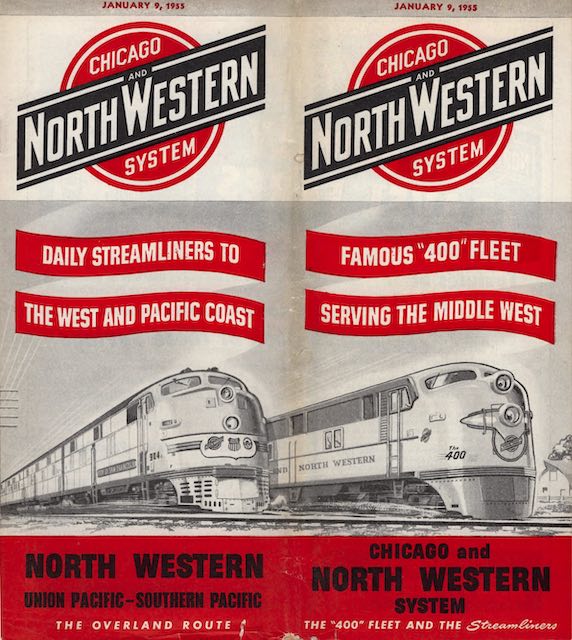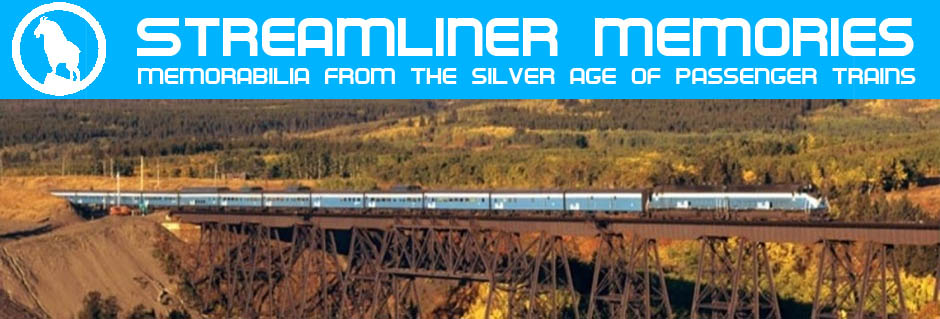Here’s a timetable from just a few months before Union Pacific yanked its passenger trains away from the North Western and gave them to the Milwaukee Road instead. The schedule shows three trains a day between Chicago and Los Angeles, but one of them wasn’t real.
 Click image to download a 28.2-MB PDF of this timetable from the Ellery Goode collection.
Click image to download a 28.2-MB PDF of this timetable from the Ellery Goode collection.
Just a year before, C&NW-UP’s line-up from Chicago to Los Angeles included the City of Los Angeles, Los Angeles Limited, and Gold Coast. On January 15, 1954, the heavyweight Los Angeles Limited was replaced with the new streamlined Challenger. The Gold Coast was still on the timetable, but it disappeared at the end of 1954 to be replaced by a train known on this timetable only as 13-27-9 westbound and 10-28-14 eastbound.
As the multiple numbers suggest, that was not a single train but two different trains, one between Chicago and Ogden and one between Ogden and Los Angeles. According to Union Pacific’s January 1955 timetable, the Ogden-LA portion was the City of St. Louis and the Chicago-Ogden portion was the San Francisco Overland. C&NW didn’t use any of these names and used a different number from the UP for its portion of the Overland (13 instead of 27 westbound, 14 instead of 28 eastbound).
There were no through cars, so both coach and sleeping car passengers had to change trains in Ogden at 8:45 in the evening westbound and 6:05 in the morning eastbound. The train schedules are shown for people who, for one reason or another, didn’t want to ride the City or Challenger, but there really wasn’t a third train.
The schedules for the San Francisco corridor show the City of San Francisco and a second, unnamed train which is, of course, the San Francisco Overland. The C&NW timetable indicates that a change of trains was needed at Omaha with the change in train number; the UP timetable disagrees and says passengers could go through from Chicago to Oakland without changing cars or trains. The Overland also connected at Omaha to a secondary train to Denver.
The City of Portland is the only train shown between Chicago and Portland. The former Chicago-Portland Portland Rose had been rerouted to St. Louis and the Gold Coast, which previously served as the Rose‘s connection to Chicago, had been discontinued.
Despite all the discontinuances, the North Western still had quite a line up of daily trains from Chicago to Omaha. The parade began at 9:00 am when the Challenger left Chicago. This was followed at 10:45 am by the train that the Union Pacific still called the San Francisco Overland. The city trains all left in the late afternoon: Denver at 5:00 pm, Portland at 5:30, San Francisco at 7:00, and Los Angeles at 7:15. Finally, at 9:00 pm, an unnamed train, #5, left Chicago for Omaha that did not connect with any UP trains. It returned as #6, leaving Omaha at 8:00 pm and arriving in Chicago at 7:00 am.
The timetable notes in several places that one more train, the National Parks Special, would operate in the summer. It would leave Chicago at 1:30 pm on Saturdays only, and send cars to both West Yellowstone and Cedar City, Utah.
Of course, C&NW had plenty of other trains, including the Twin Cities 400, which took just 380 minutes to go the 399 miles from Chicago to St. Paul; the overnight Chicago-Twin Cities North Western Limited, which took 520 minutes for the same trip; three other Chicago-Twin Cities trains; 13 weekday trains a day between Chicago and Milwaukee; two trains a day between the Twin Cities and Omaha; three trains a day between Chicago and Duluth; plus trains to Green Bay, Ashland, Madison, and other Wisconsin cities.
Some of these were various 400s: the Dakota 400 to Rapid City; the Flambeau 400 to Ashland; the Peninsula 400 to Ishpeming, Valley 400 to Menominee, and the Shoreland 400 from Menominee to Chicago. There was even a rather slow Commuter 400 that was noted as streamlined between Chicago and Milwaukee but hauled by steam between Milwaukee and Green Bay, suggesting that C&NW had overused the 400 moniker. Apparently, what distinguished 400s from lesser trains was not speed (except the Twin Cities 400) but the fact that they carried bar cars.

The reasons UP decided to change over to the Milwaukee Road basically came down to:
1. The poor condition of CNW’s tracks between Chicago and Omaha. Particularly for its flagship trains, UP felt that the passengers expected not to be jostled around while trying to sleep.
2. CNW had accumulated a large car utilization deficit and owed UP over $1,000,000 as a result. UP management came to the conclusion the CNW was not in a position to make good, and that if they did not make the change the deficit would continue to grow.
A similar situation developed several years later with Rock Island and SP. The Rock was in such godawful shape financially that they could not hold up their end of maintaining the Golden State equipment pool. IIRC, the arrangement was that SP would contribute sleeping cars, while RI furnished the dining & lounge and chair car equipment. Fewer and fewer RI cars would make it into the consists of trains like the Golden State, leaving SP to make up the difference. When RI finally got the OK to take the Golden State off, one has to wonder how long it took SP to get their cars back.